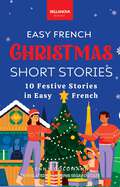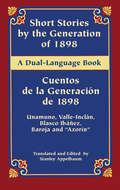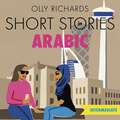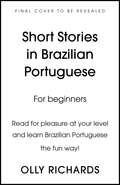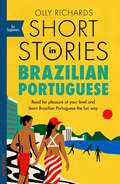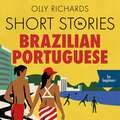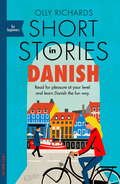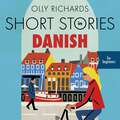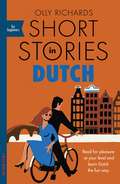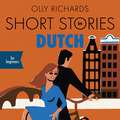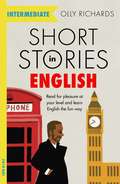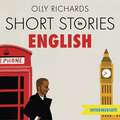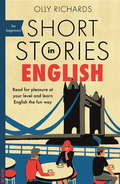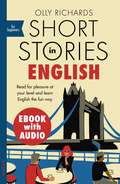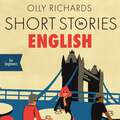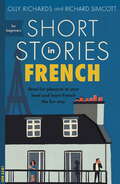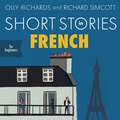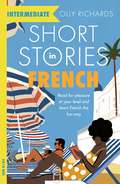- Table View
- List View
Short Christmas Stories in Easy French: 10 histoires festives en français facile
by Jenny GoldmannVous rêvez d’un Noël blanc tout en souhaitant améliorer votre français ? Plongez dans cette collection magique de dix contes de Noël. Ils sont parfaits pour se mettre dans l’ambiance des Fêtes ! Découvrez la chaleur des réunions de famille et laissez-vous emporter par des contes qui, en plus de vous réchauffer le cœur, vous permettront d’améliorer vos compétences en français. Chaque histoire est conçue pour capter votre intérêt et vous emmener dans une aventure hivernale française amusante. Pour ceux qui commencent leur voyage en français ou ceux qui sont sur le chemin depuis un certain temps, ces contes sont un mélange parfait de festivités et d’apprentissage. Contenu du livre : • Du français simple, facile à comprendre • 10 histoires de Noël réconfortantes • Des personnages drôles et passionants • Parfait pour les apprenants du français de niveau A2-B1 du CECRL (débutant à intermédiaire) • Des listes de mots, de courts questionnaires et des questions de discussion intéressantes Voyagez avec nos personnages à travers des paysages féériques enneigés, des marchés de Noël animés et des moments d’intimité au coin d’une cheminée rayonnante. Dans un langage à la fois simple et amusant, ces histoires sont conçues pour susciter une joie festive chez les apprenants. Après chaque histoire, vous trouverez des compléments d’apprentissage utiles, comme des listes de mots et des questionnaires pour vérifier ce que vous avez appris. Des questions de discussion intéressantes vous amèneront également à réfléchir à Noël de manière plus personnelle, tout en vous aidant à améliorer vos compétences en matière d’expression orale. Alors, servez-vous une tasse de chocolat chaud, installez-vous confortablement et plongez-vous dans ces histoires de Noël. Elles vous guideront dans le monde merveil
Short Stories by the Generation of 1898/Cuentos de la Generación de 1898: A Dual-Language Book
by Miguel De Unamuno Stanley Appelbaum Vicente Blasco Ibáñez Pío Baroja Ramón del Valle-Inclán Azorín"These 13 short stories by 5 authors of the era include 4 tales by Miguel de Unamuno -- famed as a novelist, essayist, and poet, and one of the few internationally known and acclaimed Spanish writers of the 20th century -- along with the works of Valle-Inclán, Blasco Ibánez, Baroja, and "Azorín" (José Martínez Ruiz).
Short Stories in Arabic for Intermediate Learners: Read for pleasure at your level, expand your vocabulary and learn Modern Standard Arabic the fun way! (Foreign Language Graded Reader Series)
by Olly RichardsAn unmissable collection of eight unconventional and captivating short stories for young and adult learners of Arabic."Olly's top-notch language-learning insights are right in line with the best of what we know from neuroscience and cognitive psychology about how to learn effectively. I love his work - and you will too!" - Barbara Oakley, PhD, Author of New York Times bestseller A Mind for Numbers Short Stories in Arabic for Intermediate Learners has been written especially for students from low-intermediate to intermediate level, designed to give a sense of achievement, a feeling of progress and most importantly - enjoyment! Mapped to B1-B2 on the Common European Framework of Reference (CEFR), these eight captivating stories are designed to give you a sense of achievement and a feeling of progress when reading.What does this book give you?- Eight stories in a variety of exciting genres, from science fiction and crime to history and thriller - making reading fun, while you learn a wide range of new vocabulary- Controlled language at your level, including the 1000 most frequent words, to help you progress confidently- Authentic spoken dialogues, to help you learn conversational expressions and improve your speaking ability- Accessible grammar so you learn new structures naturally, in a stress-free way- Pleasure! It's much easier to learn a new language when you're having fun, and research shows that if you're enjoying reading in a foreign language, you won't experience the usual feelings of frustration - 'It's too hard!' 'I don't understand!'Carefully curated to make learning a new language easy, these stories include key features that will support and consolidate your progress, including: - A glossary for bolded words in each text - Full plot summary- A bilingual word list- Comprehension questions after each chapter. As a result, you will be able to focus on enjoying reading, delighting in your improved range of vocabulary and grasp of the language, without ever feeling overwhelmed or frustrated. From science fiction to fantasy, to crime and thrillers, Short Stories in Arabic for Intermediate Learners will make learning Arabic easy and enjoyable.(P) 2020 Hodder & Stoughton Ltd
Short Stories in Brazilian Portuguese for Beginners: Read For Pleasure At Your Level, Expand Your Vocabulary And Learn Brazilian Portuguese The Fun Way! (Foreign Language Graded Ser.)
by Olly Richards"Olly's top-notch language-learning insights are right in line with the best of what we know from neuroscience and cognitive psychology about how to learn effectively. I love his work - and you will too!" - Barbara Oakley, PhD, Author of New York Times bestseller A Mind for Numbers An unmissable collection of eight unconventional and captivating short stories for young adult and adult learners of Brazilian Portuguese. Short Stories in Brazilian Portuguese for Beginners has been written especially for students from high-beginner to low-intermediate level, designed to give a sense of achievement, a feeling of progress and most importantly - enjoyment! Mapped to A2-B1 on the Common European Framework of Reference (CEFR) for languages, these eight captivating stories are designed to give you a sense of achievement and a feeling of progress when reading.What does this book give you? - Eight stories in a variety of exciting genres, from science fiction and crime to history and thriller - making reading fun, while you learn a wide range of new vocabulary- Controlled language at your level to help you progress confidently- Realistic spoken dialogues, to help you learn conversational expressions and improve your speaking ability- Accessible grammar so you learn new structures naturally, in a stress-free way - Beautiful illustrations accompanying each story, to set the scene and support your understanding- Pleasure! Research shows that if you're enjoying reading in a foreign language, you won't experience the usual feelings of frustration - 'It's too hard!' 'I don't understand!' Carefully curated to make learning a new language easy, these stories include key features that will support and consolidate your progress, including: - A glossary for bolded words in each chapter- Full plot summary- A bilingual word list- Comprehension questions after each chapter. As a result, you will be able to focus on enjoying reading, delighting in your improved range of vocabulary and grasp of the language, without ever feeling overwhelmed. From science fiction to fantasy, to crime and thrillers, Short Stories in Brazilian Portuguese for Beginners will make learning Brazilian Portuguese easy and enjoyable.
Short Stories in Brazilian Portuguese for Beginners: Read for pleasure at your level, expand your vocabulary and learn Brazilian Portuguese the fun way!
by Olly RichardsAn unmissable collection of eight unconventional and captivating short stories for young and adult learners of Brazilian Portuguese."Olly's top-notch language-learning insights are right in line with the best of what we know from neuroscience and cognitive psychology about how to learn effectively. I love his work - and you will too!" - Barbara Oakley, PhD, Author of New York Times bestseller A Mind for NumbersShort Stories in Brazilian Portuguese for Beginners has been written especially for students from high-beginner to low-intermediate level, designed to give a sense of achievement, a feeling of progress and most importantly - enjoyment! Mapped to A2-B1 on the Common European Framework of Reference (CEFR) for languages, these eight captivating stories are designed to give you a sense of achievement and a feeling of progress when reading.What does this book give you?- Eight stories in a variety of exciting genres, from science fiction and crime to history and thriller - making reading fun, while you learn a wide range of new vocabulary- Controlled language at your level to help you progress confidently- Realistic spoken dialogues, to help you learn conversational expressions and improve your speaking ability- Accessible grammar so you learn new structures naturally, in a stress-free way- Beautiful illustrations accompanying each story, to set the scene and support your understanding- Pleasure! Research shows that if you're enjoying reading in a foreign language, you won't experience the usual feelings of frustration - 'It's too hard!' 'I don't understand!'Carefully curated to make learning a new language easy, these stories include key features that will support and consolidate your progress, including: - A glossary for bolded words in each chapter- Full plot summary- A bilingual word list- Comprehension questions after each chapter. As a result, you will be able to focus on enjoying reading, delighting in your improved range of vocabulary and grasp of the language, without ever feeling overwhelmed. From science fiction to fantasy, to crime and thrillers, Short Stories in Brazilian Portuguese for Beginners will make learning Brazilian Portuguese easy and enjoyable.
Short Stories in Brazilian Portuguese for Beginners: Read for pleasure at your level, expand your vocabulary and learn Brazilian Portuguese the fun way! (Foreign Language Graded Reader Series)
by Olly RichardsAn unmissable collection of eight unconventional and captivating short stories for young and adult learners of Brazilian Portuguese."Olly's top-notch language-learning insights are right in line with the best of what we know from neuroscience and cognitive psychology about how to learn effectively. I love his work - and you will too!" - Barbara Oakley, PhD, Author of New York Times bestseller A Mind for Numbers Short Stories in Brazilian Portuguese for Beginners has been written especially for students from high-beginner to low-intermediate level, designed to give a sense of achievement, a feeling of progress and most importantly - enjoyment! Mapped to A2-B1 on the Common European Framework of Reference (CEFR) for languages, these eight captivating stories are designed to give you a sense of achievement and a feeling of progress when reading.What does this book give you?- Eight stories in a variety of exciting genres, from science fiction and crime to history and thriller - making reading fun, while you learn a wide range of new vocabulary- Controlled language at your level to help you progress confidently- Realistic spoken dialogues, to help you learn conversational expressions and improve your speaking ability- Accessible grammar so you learn new structures naturally, in a stress-free way- Beautiful illustrations accompanying each story, to set the scene and support your understanding- Pleasure! Research shows that if you're enjoying reading in a foreign language, you won't experience the usual feelings of frustration - 'It's too hard!' 'I don't understand!'Carefully curated to make learning a new language easy, these stories include key features that will support and consolidate your progress, including: - A glossary for bolded words in each chapter- Full plot summary- A bilingual word list- Comprehension questions after each chapter. As a result, you will be able to focus on enjoying reading, delighting in your improved range of vocabulary and grasp of the language, without ever feeling overwhelmed. From science fiction to fantasy, to crime and thrillers, Short Stories in Brazilian Portuguese for Beginners will make learning Brazilian Portuguese easy and enjoyable.
Short Stories in Brazilian Portuguese for Beginners: Read for pleasure at your level, expand your vocabulary and learn Brazilian Portuguese the fun way! (Readers)
by Olly RichardsAn unmissable collection of eight unconventional and captivating short stories for young and adult learners of Brazilian Portuguese."Olly's top-notch language-learning insights are right in line with the best of what we know from neuroscience and cognitive psychology about how to learn effectively. I love his work - and you will too!" - Barbara Oakley, PhD, Author of New York Times bestseller A Mind for Numbers Short Stories in Brazilian Portuguese for Beginners has been written especially for students from high-beginner to low-intermediate level, designed to give a sense of achievement, a feeling of progress and most importantly - enjoyment! Mapped to A2-B1 on the Common European Framework of Reference (CEFR), these eight captivating stories are designed to give you a sense of achievement and a feeling of progress when reading.What does this book give you?- Eight stories in a variety of exciting genres, from science fiction and crime to history and thriller - making reading fun, while you learn a wide range of new vocabulary- Controlled language at your level, including the 1000 most frequent words, to help you progress confidently- Authentic spoken dialogues, to help you learn conversational expressions and improve your speaking ability- Accessible grammar so you learn new structures naturally, in a stress-free way- Pleasure! It's much easier to learn a new language when you're having fun, and research shows that if you're enjoying reading in a foreign language, you won't experience the usual feelings of frustration - 'It's too hard!' 'I don't understand!'Carefully curated to make learning a new language easy, these stories include key features that will support and consolidate your progress, including: - A glossary for bolded words in each text - Full plot summary- A bilingual word list- Comprehension questions after each chapter. As a result, you will be able to focus on enjoying reading, delighting in your improved range of vocabulary and grasp of the language, without ever feeling overwhelmed or frustrated. From science fiction to fantasy, to crime and thrillers, Short Stories in Brazilian Portuguese for Beginners will make learning Brazilian Portuguese easy and enjoyable. (P) 2019 Hodder & Stoughton Ltd
Short Stories in Danish for Beginners: Read for pleasure at your level, expand your vocabulary and learn Danish the fun way!
by Olly RichardsAn unmissable collection of eight unconventional and captivating short stories for young adult and adult intermediate learners of Danish."Olly's top-notch language-learning insights are right in line with the best of what we know from neuroscience and cognitive psychology about how to learn effectively. I love his work - and you will too!" - Barbara Oakley, PhD, Author of New York Times bestseller A Mind for NumbersShort Stories in Danish for Beginners has been written especially for learners from beginner to low-intermediate level, designed to give a sense of achievement, a feeling of progress and most importantly - enjoyment! Mapped to A2-B1 on the Common European Framework of Reference (CEFR) for languages, these eight captivating stories are designed to give you a sense of achievement and a feeling of progress when reading.What does this book give you?- Eight stories in a variety of exciting genres, from science fiction and crime to history and thriller - making reading fun, while you learn a wide range of new vocabulary- Controlled language at your level to help you progress confidently- Accessible grammar so you learn new structures naturally, in a stress-free way- Realistic spoken dialogues to help you learn conversational expressions and improve your speaking ability- Beautiful illustrations accompanying each story, to set the scene and support your understanding- Pleasure! Research shows that if you're enjoying reading in a foreign language, you won't experience the usual feelings of frustration - 'It's too hard!' 'I don't understand!'Carefully curated to make learning a new language easy, these stories include key features that will support and consolidate your progress, including: - A glossary for bolded words in each chapter- Full plot summary- A bilingual word list- Comprehension questions after each chapter. As a result, you will be able to focus on enjoying reading, delighting in your improved range of vocabulary and grasp of the language, without ever feeling overwhelmed. From science fiction to fantasy, to crime and thrillers, Short Stories in Danish for Beginners will make learning Danish easy and enjoyable.
Short Stories in Danish for Beginners: Read for pleasure at your level, expand your vocabulary and learn Danish the fun way! (Foreign Language Graded Reader Series)
by Olly RichardsAn unmissable collection of eight unconventional and captivating short stories for young adult and adult intermediate learners of Danish."Olly's top-notch language-learning insights are right in line with the best of what we know from neuroscience and cognitive psychology about how to learn effectively. I love his work - and you will too!" - Barbara Oakley, PhD, Author of New York Times bestseller A Mind for Numbers Short Stories in Danish for Beginners has been written especially for learners from beginner to low-intermediate level, designed to give a sense of achievement, a feeling of progress and most importantly - enjoyment! Mapped to A2-B1 on the Common European Framework of Reference (CEFR) for languages, these eight captivating stories are designed to give you a sense of achievement and a feeling of progress when reading.What does this book give you?- Eight stories in a variety of exciting genres, from science fiction and crime to history and thriller - making reading fun, while you learn a wide range of new vocabulary- Controlled language at your level to help you progress confidently- Accessible grammar so you learn new structures naturally, in a stress-free way- Realistic spoken dialogues to help you learn conversational expressions and improve your speaking ability- Beautiful illustrations accompanying each story, to set the scene and support your understanding- Pleasure! Research shows that if you're enjoying reading in a foreign language, you won't experience the usual feelings of frustration - 'It's too hard!' 'I don't understand!'Carefully curated to make learning a new language easy, these stories include key features that will support and consolidate your progress, including: - A glossary for bolded words in each chapter- Full plot summary- A bilingual word list- Comprehension questions after each chapter. As a result, you will be able to focus on enjoying reading, delighting in your improved range of vocabulary and grasp of the language, without ever feeling overwhelmed. From science fiction to fantasy, to crime and thrillers, Short Stories in Danish for Beginners will make learning Danish easy and enjoyable.
Short Stories in Danish for Beginners: Read for pleasure at your level, expand your vocabulary and learn Danish the fun way! (Foreign Language Graded Reader Series)
by Olly RichardsAn unmissable collection of eight unconventional and captivating short stories for young adult and adult intermediate learners of Danish."Olly's top-notch language-learning insights are right in line with the best of what we know from neuroscience and cognitive psychology about how to learn effectively. I love his work - and you will too!" - Barbara Oakley, PhD, Author of New York Times bestseller A Mind for Numbers Short Stories in Danish for Beginners has been written especially for students from high-beginner to low-intermediate level, designed to give a sense of achievement, a feeling of progress and most importantly - enjoyment! Mapped to A2-B1 on the Common European Framework of Reference (CEFR), these eight captivating stories are designed to give you a sense of achievement and a feeling of progress when reading.What does this book give you?- Eight stories in a variety of exciting genres, from science fiction and crime to history and thriller - making reading fun, while you learn a wide range of new vocabulary- Controlled language at your level, including the 1000 most frequent words, to help you progress confidently- Authentic spoken dialogues, to help you learn conversational expressions and improve your speaking ability- Pleasure! It's much easier to learn a new language when you're having fun, and research shows that if you're enjoying reading in a foreign language, you won't experience the usual feelings of frustration - 'It's too hard!' 'I don't understand!'- Accessible grammar so you learn new structures naturally, in a stress-free wayCarefully curated to make learning a new language easy, these stories include key features that will support and consolidate your progress, including: - A glossary for bolded words in each text - Full plot summary- A bilingual word list- Comprehension questions after each chapter. As a result, you will be able to focus on enjoying reading, delighting in your improved range of vocabulary and grasp of the language, without ever feeling overwhelmed or frustrated. From science fiction to fantasy, to crime and thrillers, Short Stories in Danish for Beginners will make learning Danish easy and enjoyable.(P) 2019 Hodder & Stoughton Ltd
Short Stories in Dutch for Beginners: Read for pleasure at your level, expand your vocabulary and learn Dutch the fun way!
by Olly RichardsAn unmissable collection of eight unconventional and captivating short stories for young and adult learners of Dutch."Olly's top-notch language-learning insights are right in line with the best of what we know from neuroscience and cognitive psychology about how to learn effectively. I love his work - and you will too!" - Barbara Oakley, PhD, Author of New York Times bestseller A Mind for NumbersShort Stories in Dutch for Beginners has been written especially for learners from high-beginner to low-intermediate level, designed to give a sense of achievement, and most importantly - enjoyment! Mapped to A2-B1 on the Common European Framework of Reference (CEFR) for languages, these eight captivating stories will both entertain you, and give you a feeling of progress when reading.What does this book give you?· Eight stories in a variety of exciting genres, from science fiction and crime to history and thriller - making reading fun, while you learn a wide range of new vocabulary· Controlled language at your level to help you progress confidently· Realistic spoken dialogues, to help you learn conversational expressions and improve your speaking ability· Accessible grammar so you learn new structures naturally, in a stress-free way· Beautiful illustrations accompanying each story, to set the scene and support your understanding· Pleasure! Research shows that if you're enjoying reading in a foreign language, you won't experience the usual feelings of frustration - 'It's too hard!' 'I don't understand!'Carefully curated to make learning a new language easy, these stories include key features that will support and consolidate your progress, including:· A glossary for bolded words in each chapter· A bilingual word list· Full plot summary· Comprehension questions after each chapter. As a result, you will be able to focus on enjoying reading, delighting in your improved range of vocabulary and grasp of the language, without ever feeling overwhelmed. From science fiction to fantasy, to crime and thrillers, Short Stories in Dutch for Beginners will make learning Dutch easy and enjoyable.
Short Stories in Dutch for Beginners: Read for pleasure at your level, expand your vocabulary and learn Dutch the fun way! (Foreign Language Graded Reader Series)
by Olly RichardsAn unmissable collection of eight unconventional and captivating short stories for young and adult learners of Dutch."Olly's top-notch language-learning insights are right in line with the best of what we know from neuroscience and cognitive psychology about how to learn effectively. I love his work - and you will too!" - Barbara Oakley, PhD, Author of New York Times bestseller A Mind for NumbersShort Stories in Dutch for Beginners has been written especially for learners from high-beginner to low-intermediate level, designed to give a sense of achievement, and most importantly - enjoyment! Mapped to A2-B1 on the Common European Framework of Reference (CEFR) for languages, these eight captivating stories will both entertain you, and give you a feeling of progress when reading.What does this book give you?· Eight stories in a variety of exciting genres, from science fiction and crime to history and thriller - making reading fun, while you learn a wide range of new vocabulary· Controlled language at your level to help you progress confidently· Realistic spoken dialogues, to help you learn conversational expressions and improve your speaking ability· Accessible grammar so you learn new structures naturally, in a stress-free way· Beautiful illustrations accompanying each story, to set the scene and support your understanding· Pleasure! Research shows that if you're enjoying reading in a foreign language, you won't experience the usual feelings of frustration - 'It's too hard!' 'I don't understand!'Carefully curated to make learning a new language easy, these stories include key features that will support and consolidate your progress, including:· A glossary for bolded words in each chapter· A bilingual word list· Full plot summary· Comprehension questions after each chapter. As a result, you will be able to focus on enjoying reading, delighting in your improved range of vocabulary and grasp of the language, without ever feeling overwhelmed. From science fiction to fantasy, to crime and thrillers, Short Stories in Dutch for Beginners will make learning Dutch easy and enjoyable.
Short Stories in Dutch for Beginners: Read for pleasure at your level, expand your vocabulary and learn Dutch the fun way! (Foreign Language Graded Reader Series)
by Olly RichardsAn unmissable collection of eight unconventional and captivating short stories for young and adult learners of Dutch."Olly's top-notch language-learning insights are right in line with the best of what we know from neuroscience and cognitive psychology about how to learn effectively. I love his work - and you will too!" - Barbara Oakley, PhD, Author of New York Times bestseller A Mind for NumbersShort Stories in Dutch for Beginners has been written especially for students from high-beginner to low-intermediate level, designed to give a sense of achievement, and most importantly - enjoyment! Mapped to A2-B1 on the Common European Framework of Reference, these eight captivating stories will both entertain you, and give you a feeling of progress when reading.What does this book give you?· Eight stories in a variety of exciting genres, from science fiction and crime to history and thriller - making reading fun, while you learn a wide range of new vocabulary· Controlled language at your level, including the 1000 most frequent words, to help you progress confidently· Authentic spoken dialogues, to help you learn conversational expressions and improve your speaking ability· Pleasure! It's much easier to learn a new language when you're having fun, and research shows that if you're enjoying reading in a foreign language, you won't experience the usual feelings of frustration - 'It's too hard!' 'I don't understand!'· Accessible grammar so you learn new structures naturally, in a stress-free wayCarefully curated to make learning a new language easy, these stories include key features that will support and consolidate your progress, including· A glossary for bolded words in each text· A bilingual word list· Full plot summary· Comprehension questions after each chapter. As a result, you will be able to focus on enjoying reading, delighting in your improved range of vocabulary and grasp of the language, without ever feeling overwhelmed or frustrated. From science fiction to fantasy, to crime and thrillers, Short Stories in Dutch for Beginners will make learning Dutch easy and enjoyable.(P) 2019 Hodder & Stoughton Ltd
Short Stories in English for Intermediate Learners: Read for pleasure at your level, expand your vocabulary and learn English the fun way!
by Olly RichardsAn unmissable collection of eight unconventional and captivating short stories for young adult and adult intermediate learners of Italian.Olly's top-notch language-learning insights are right in line with the best of what we know from neuroscience and cognitive psychology about how to learn effectively. I love his work - and you will too! - Barbara Oakley, PhD, Author of New York Times bestseller A Mind for NumbersShort Stories in Italian for Intermediate Learners has been written specifically for students from a low-intermediate to intermediate level, designed to give a sense of achievement, and most importantly - enjoyment! Mapped to B1-B2 of the Common European Framework of Reference, these eight captivating stories will both entertain you, and give you a feeling of progress when reading.What does this book give you?· Eight stories in a variety of exciting genres, from science fiction and crime to history and thriller - making reading fun, while you learn a wide range of new vocabulary· Controlled language at your level to help you progress confidently· Realistic spoken dialogues to help you learn conversational expressions and improve your speaking ability· Beautiful illustrations accompanying each story, to set the scene and support your understanding· Accessible grammar so you learn new structures naturally, in a stress-free way· Pleasure! Research shows that if you're enjoying reading in a foreign language, you won't experience the usual feelings of frustration - 'It's too hard!' 'I don't understand!'With intriguing plots that will spark your imagination and keep you reading, Short Stories in Italian will take your grasp of Italian to the next level with key features to support and consolidate your progress, including:· A glossary for bolded words in each text· A bilingual word list· Full plot summary· Comprehension questions after each chapter. As a result, you will be able to focus on enjoying reading, delighting in your improved range of vocabulary and grasp of the language all without ever feeling overwhelmed. From science fiction to fantasy, to crime and thrillers, Short Stories in Italian for Intermediate Learners uses reading as the perfect tool to not only delight in learning Italian, but to accelerate your journey towards fluency.
Short Stories in English for Intermediate Learners: Read for pleasure at your level, expand your vocabulary and learn English the fun way! (Coffee Break Series)
by Olly RichardsAn unmissable collection of eight unconventional and captivating short stories for young adult and adult intermediate learners of English.Olly's top-notch language-learning insights are right in line with the best of what we know from neuroscience and cognitive psychology about how to learn effectively. I love his work - and you will too! - Barbara Oakley, PhD, Author of New York Times bestseller A Mind for NumbersShort Stories in English for Intermediate Learners has been written specifically for students from a low-intermediate to intermediate level, designed to give a sense of achievement, and most importantly - enjoyment! Mapped to B1- approaching B2 of the Common European Framework of Reference, these eight captivating stories will both entertain you, and give you a feeling of progress when reading.What does this book give you?· Eight stories in a variety of exciting genres, from science fiction and crime to history and thriller - making reading fun, while you learn a wide range of new vocabulary· Controlled language at your level to help you progress confidently· Realistic spoken dialogues to help you learn conversational expressions and improve your speaking ability· Pleasure! Research shows that if you're enjoying reading in a foreign language, you won't experience the usual feelings of frustration - 'It's too hard!' 'I don't understand!'· Accessible grammar so you learn new structures naturally, in a stress-free wayWith intriguing plots that will spark your imagination and keep you reading, Short Stories in English will take your grasp of English to the next level with key features to support and consolidate your progress, including:· Full plot summary· Comprehension questions after each chapter· A glossary for bolded words in each text· A bilingual word list.As a result, you will be able to focus on enjoying reading, delighting in your improved range of vocabulary and grasp of the language all without ever feeling overwhelmed. From science fiction to fantasy, to crime and thrillers, Short Stories in English for Intermediate Learners uses reading as the perfect tool to not only delight in learning English, but to accelerate your journey towards fluency.(P) 2019 Hodder & Stoughton Ltd
Short Stories in English for Intermediate Learners: Read for pleasure at your level, expand your vocabulary and learn English the fun way! (Foreign Language Graded Reader Series)
by Olly RichardsAn unmissable collection of eight unconventional and captivating short stories for young adult and adult intermediate learners of Italian.Olly's top-notch language-learning insights are right in line with the best of what we know from neuroscience and cognitive psychology about how to learn effectively. I love his work - and you will too! - Barbara Oakley, PhD, Author of New York Times bestseller A Mind for NumbersShort Stories in Italian for Intermediate Learners has been written specifically for students from a low-intermediate to intermediate level, designed to give a sense of achievement, and most importantly - enjoyment! Mapped to B1-B2 of the Common European Framework of Reference, these eight captivating stories will both entertain you, and give you a feeling of progress when reading.What does this book give you?· Eight stories in a variety of exciting genres, from science fiction and crime to history and thriller - making reading fun, while you learn a wide range of new vocabulary· Controlled language at your level to help you progress confidently· Realistic spoken dialogues to help you learn conversational expressions and improve your speaking ability· Beautiful illustrations accompanying each story, to set the scene and support your understanding· Accessible grammar so you learn new structures naturally, in a stress-free way· Pleasure! Research shows that if you're enjoying reading in a foreign language, you won't experience the usual feelings of frustration - 'It's too hard!' 'I don't understand!'With intriguing plots that will spark your imagination and keep you reading, Short Stories in Italian will take your grasp of Italian to the next level with key features to support and consolidate your progress, including:· A glossary for bolded words in each text· A bilingual word list· Full plot summary· Comprehension questions after each chapter. As a result, you will be able to focus on enjoying reading, delighting in your improved range of vocabulary and grasp of the language all without ever feeling overwhelmed. From science fiction to fantasy, to crime and thrillers, Short Stories in Italian for Intermediate Learners uses reading as the perfect tool to not only delight in learning Italian, but to accelerate your journey towards fluency.
Short Stories in English for Beginners: Read for pleasure at your level, expand your vocabulary and learn English the fun way! (Foreign Language Graded Reader Ser.)
by Olly RichardsAn unmissable collection of eight unconventional and captivating short stories for young and adult learners."I love Olly's work - and you will too!" - Barbara Oakley, PhD, Author of New York Times bestseller A Mind for NumbersShort Stories in English for Beginners has been written especially for students from beginner to intermediate level, designed to give a sense of achievement, and most importantly - enjoyment! Mapped to A2-B1 on the Common European Framework of Reference, these eight captivating stories will both entertain you, and give you a feeling of progress when listening.What does this book give you?· Eight stories in a variety of exciting genres, from science fiction and crime to history and thriller - making learning fun, while you gain a wide range of new vocabulary· Controlled language at your level, including the 1000 most frequent words, to help you progress confidently· Authentic spoken dialogues, to help you learn conversational expressions and improve your speaking ability· Pleasure! It's much easier to learn a new language when you're having fun, and research shows that if you're enjoying listening in a foreign language, you won't experience the usual feelings of frustration - 'It's too hard!' 'I don't understand!'· Accessible grammar so you learn new structures naturally, in a stress-free wayCarefully curated to make learning a new language easy, these stories will entertain you, while at the same time allowing you to benefit from an improved range of vocabulary and a better grasp of the language, without ever feeling overwhelmed or frustrated. From science fiction to fantasy, to crime and thrillers, Short Stories in English for Beginners will make learning English easy and enjoyable.
Short Stories in English for Beginners: Read for pleasure at your level, expand your vocabulary and learn English the fun way! (Foreign Language Graded Reader Series)
by Olly RichardsAn unmissable collection of eight unconventional and captivating short stories for young and adult learners."I love Olly's work - and you will too!" - Barbara Oakley, PhD, Author of New York Times bestseller A Mind for NumbersShort Stories in English for Beginners has been written especially for students from beginner to intermediate level, designed to give a sense of achievement, and most importantly - enjoyment! Mapped to A2-B1 on the Common European Framework of Reference, these eight captivating stories will both entertain you, and give you a feeling of progress when listening.What does this book give you?· Eight stories in a variety of exciting genres, from science fiction and crime to history and thriller - making learning fun, while you gain a wide range of new vocabulary· Controlled language at your level, including the 1000 most frequent words, to help you progress confidently· Authentic spoken dialogues, to help you learn conversational expressions and improve your speaking ability· Pleasure! It's much easier to learn a new language when you're having fun, and research shows that if you're enjoying listening in a foreign language, you won't experience the usual feelings of frustration - 'It's too hard!' 'I don't understand!'· Accessible grammar so you learn new structures naturally, in a stress-free wayCarefully curated to make learning a new language easy, these stories will entertain you, while at the same time allowing you to benefit from an improved range of vocabulary and a better grasp of the language, without ever feeling overwhelmed or frustrated. From science fiction to fantasy, to crime and thrillers, Short Stories in English for Beginners will make learning English easy and enjoyable.
Short Stories in English for Beginners: Read for pleasure at your level, expand your vocabulary and learn English the fun way! (Foreign Language Graded Reader Series)
by Olly RichardsAn unmissable collection of eight unconventional and captivating short stories for young and adult learners."I love Olly's work - and you will too!" - Barbara Oakley, PhD, Author of New York Times bestseller A Mind for NumbersShort Stories in English for Beginners has been written especially for students from beginner to intermediate level, designed to give a sense of achievement, and most importantly - enjoyment! Mapped to A2-B1 on the Common European Framework of Reference, these eight captivating stories will both entertain you, and give you a feeling of progress when listening.What does this book give you?· Eight stories in a variety of exciting genres, from science fiction and crime to history and thriller - making learning fun, while you gain a wide range of new vocabulary· Controlled language at your level, including the 1000 most frequent words, to help you progress confidently· Authentic spoken dialogues, to help you learn conversational expressions and improve your speaking ability· Pleasure! It's much easier to learn a new language when you're having fun, and research shows that if you're enjoying listening in a foreign language, you won't experience the usual feelings of frustration - 'It's too hard!' 'I don't understand!'· Accessible grammar so you learn new structures naturally, in a stress-free wayCarefully curated to make learning a new language easy, these stories will entertain you, while at the same time allowing you to benefit from an improved range of vocabulary and a better grasp of the language, without ever feeling overwhelmed or frustrated. From science fiction to fantasy, to crime and thrillers, Short Stories in English for Beginners will make learning English easy and enjoyable.
Short Stories in English for Beginners: Read for pleasure at your level, expand your vocabulary and learn English the fun way! (Foreign Language Graded Reader Series)
by Olly RichardsAn unmissable collection of eight unconventional and captivating short stories for young and adult learners."I love Olly's work - and you will too!" - Barbara Oakley, PhD, Author of New York Times bestseller A Mind for NumbersShort Stories in English for Beginners has been written especially for students from beginner to intermediate level, designed to give a sense of achievement, and most importantly - enjoyment! Mapped to A2-B1 on the Common European Framework of Reference, these eight captivating stories will both entertain you, and give you a feeling of progress when listening.What does this book give you?· Eight stories in a variety of exciting genres, from science fiction and crime to history and thriller - making learning fun, while you gain a wide range of new vocabulary· Controlled language at your level, including the 1000 most frequent words, to help you progress confidently· Authentic spoken dialogues, to help you learn conversational expressions and improve your speaking ability· Pleasure! It's much easier to learn a new language when you're having fun, and research shows that if you're enjoying listening in a foreign language, you won't experience the usual feelings of frustration - 'It's too hard!' 'I don't understand!'· Accessible grammar so you learn new structures naturally, in a stress-free wayCarefully curated to make learning a new language easy, these stories will entertain you, while at the same time allowing you to benefit from an improved range of vocabulary and a better grasp of the language, without ever feeling overwhelmed or frustrated. From science fiction to fantasy, to crime and thrillers, Short Stories in English for Beginners will make learning English easy and enjoyable.
Short Stories in English for Beginners: Read for pleasure at your level, expand your vocabulary and learn English the fun way! (Foreign Language Graded Reader Series)
by Olly Richards"I love Olly's work - and you will too!" - Barbara Oakley, PhD, Author of New York Times bestseller A Mind for NumbersShort Stories in English for Beginners has been written especially for students from beginner to intermediate level, designed to give a sense of achievement, and most importantly - enjoyment! Mapped to A2-B1 on the Common European Framework of Reference, these eight captivating stories will both entertain you, and give you a feeling of progress when listening.What does this book give you?· Eight stories in a variety of exciting genres, from science fiction and crime to history and thriller - making learning fun, while you gain a wide range of new vocabulary· Controlled language at your level, including the 1000 most frequent words, to help you progress confidently· Authentic spoken dialogues, to help you learn conversational expressions and improve your speaking ability· Pleasure! It's much easier to learn a new language when you're having fun, and research shows that if you're enjoying listening in a foreign language, you won't experience the usual feelings of frustration - 'It's too hard!' 'I don't understand!'· Accessible grammar so you learn new structures naturally, in a stress-free wayCarefully curated to make learning a new language easy, these stories will entertain you, while at the same time allowing you to benefit from an improved range of vocabulary and a better grasp of the language, without ever feeling overwhelmed or frustrated. From science fiction to fantasy, to crime and thrillers, Short Stories in English for Beginners will make learning English easy and enjoyable.
Short Stories in French for Beginners: Read for pleasure at your level, expand your vocabulary and learn French the fun way! (Foreign Language Graded Reader Ser.)
by Olly Richards Richard SimcottAn unmissable collection of eight unconventional and captivating short stories for young and adult learners."I love Olly's work - and you will too!" - Barbara Oakley, PhD, Author of New York Times bestseller A Mind for NumbersShort Stories in French for Beginners has been written especially for students from beginner to intermediate level, designed to give a sense of achievement, and most importantly - enjoyment! Mapped to A2-B1 on the Common European Framework of Reference, these eight captivating stories will both entertain you, and give you a feeling of progress when reading.What does this book give you?· Eight stories in a variety of exciting genres, from science fiction and crime to history and thriller - making reading fun, while you learn a wide range of new vocabulary· Controlled language at your level, including the 1000 most frequent words, to help you progress confidently· Authentic spoken dialogues, to help you learn conversational expressions and improve your speaking ability· Pleasure! It's much easier to learn a new language when you're having fun, and research shows that if you're enjoying reading in a foreign language, you won't experience the usual feelings of frustration - 'It's too hard!' 'I don't understand!'· Accessible grammar so you learn new structures naturally, in a stress-free wayCarefully curated to make learning a new language easy, these stories include key features that will support and consolidate your progress, including· A glossary for bolded words in each text· A bilingual word list· Full plot summary· Comprehension questions after each chapter. As a result, you will be able to focus on enjoying reading, delighting in your improved range of vocabulary and grasp of the language, without ever feeling overwhelmed or frustrated. From science fiction to fantasy, to crime and thrillers, Short Stories in French for Beginners will make learning French easy and enjoyable.
Short Stories in French for Beginners: Read for pleasure at your level, expand your vocabulary and learn French the fun way! (Foreign Language Graded Reader Series)
by Olly Richards Richard SimcottAn unmissable collection of eight unconventional and captivating short stories for young and adult learners."I love Olly's work - and you will too!" - Barbara Oakley, PhD, Author of New York Times bestseller A Mind for NumbersShort Stories in French for Beginners has been written especially for students from beginner to intermediate level, designed to give a sense of achievement, and most importantly - enjoyment! Mapped to A2-B1 on the Common European Framework of Reference, these eight captivating stories will both entertain you, and give you a feeling of progress when reading.What does this book give you?· Eight stories in a variety of exciting genres, from science fiction and crime to history and thriller - making reading fun, while you learn a wide range of new vocabulary· Controlled language at your level, including the 1000 most frequent words, to help you progress confidently· Authentic spoken dialogues, to help you learn conversational expressions and improve your speaking ability· Pleasure! It's much easier to learn a new language when you're having fun, and research shows that if you're enjoying reading in a foreign language, you won't experience the usual feelings of frustration - 'It's too hard!' 'I don't understand!'· Accessible grammar so you learn new structures naturally, in a stress-free wayCarefully curated to make learning a new language easy, these stories include key features that will support and consolidate your progress, including· A glossary for bolded words in each text · Full plot summary· A bilingual word list· Comprehension questions after each chapter. As a result, you will be able to focus on enjoying reading, delighting in your improved range of vocabulary and grasp of the language, without ever feeling overwhelmed or frustrated. From science fiction to fantasy, to crime and thrillers, Short Stories in French for Beginners will make learning French easy and enjoyable.
Short Stories in French for Beginners: Read for pleasure at your level, expand your vocabulary and learn French the fun way! (Foreign Language Graded Reader Series)
by Olly Richards Richard SimcottAn unmissable collection of eight unconventional and captivating short stories for young and adult learners."I love Olly's work - and you will too!" - Barbara Oakley, PhD, Author of New York Times bestseller A Mind for NumbersShort Stories in French for Beginners has been written especially for students from beginner to intermediate level, designed to give a sense of achievement, and most importantly - enjoyment! Mapped to A2-B1 on the Common European Framework of Reference, these eight captivating stories will both entertain you, and give you a feeling of progress when listening.What does this book give you?· Eight stories in a variety of exciting genres, from science fiction and crime to history and thriller - making learning fun, while you gain a wide range of new vocabulary· Controlled language at your level, including the 1000 most frequent words, to help you progress confidently· Authentic spoken dialogues, to help you learn conversational expressions and improve your speaking ability· Pleasure! It's much easier to learn a new language when you're having fun, and research shows that if you're enjoying listening in a foreign language, you won't experience the usual feelings of frustration - 'It's too hard!' 'I don't understand!'· Accessible grammar so you learn new structures naturally, in a stress-free wayCarefully curated to make learning a new language easy, these stories will entertain you, while at the same time allowing you to benefit from an improved range of vocabulary and a better grasp of the language, without ever feeling overwhelmed or frustrated. From science fiction to fantasy, to crime and thrillers, Short Stories in French for Beginners will make learning French easy and enjoyable.
Short Stories in French for Intermediate Learners: Read for pleasure at your level, expand your vocabulary and learn French the fun way!
by Olly RichardsAn unmissable collection of eight unconventional and captivating short stories for young adult and adult intermediate learners of French.Olly's top-notch language-learning insights are right in line with the best of what we know from neuroscience and cognitive psychology about how to learn effectively. I love his work - and you will too! - Barbara Oakley, PhD, Author of New York Times bestseller A Mind for NumbersShort Stories in French for Intermediate Learners has been written especially for students from a low-intermediate to intermediate level, designed to give a sense of achievement, and most importantly - enjoyment! Mapped to B1-B2 of the Common European Framework of Reference (CEFR) for languages, these eight captivating stories will both entertain you and give you a feeling of progress when reading.What does this book give you?· Eight stories in a variety of exciting genres, from science fiction and crime to history and thriller - making reading fun, while you learn a wide range of new vocabulary· Controlled language at your level, to help you progress confidently· Realistic spoken dialogues, to help you learn conversational expressions and improve your speaking ability· Accessible grammar so you learn new structures naturally, in a stress-free way· Beautiful illustrations accompanying each story, to set the scene and support your understanding· Pleasure! Research shows that if you're enjoying reading in a foreign language, you won't experience the usual feelings of frustration - 'It's too hard!' 'I don't understand!'With intriguing plots that will spark your imagination and keep you reading, Short Stories in French for Intermediate Learners will take your grasp of French to the next level with key features to support and consolidate your progress, including:· A glossary for bold-face words in each text· A bilingual word list· Full plot summary· Comprehension questions after each chapter. As a result, you will be able to focus on enjoying reading, delighting in your improved range of vocabulary and grasp of the language, without ever feeling overwhelmed. From science fiction to fantasy, to crime and thrillers, Short Stories in French for Intermediate Learners uses reading as the perfect tool to not only delight in learning French, but to accelerate your journey towards fluency.Use the code inside the book and ebook to access the free bonus story and the discounted audiobook on our Language Readers Library site or on the Language Readers app.
